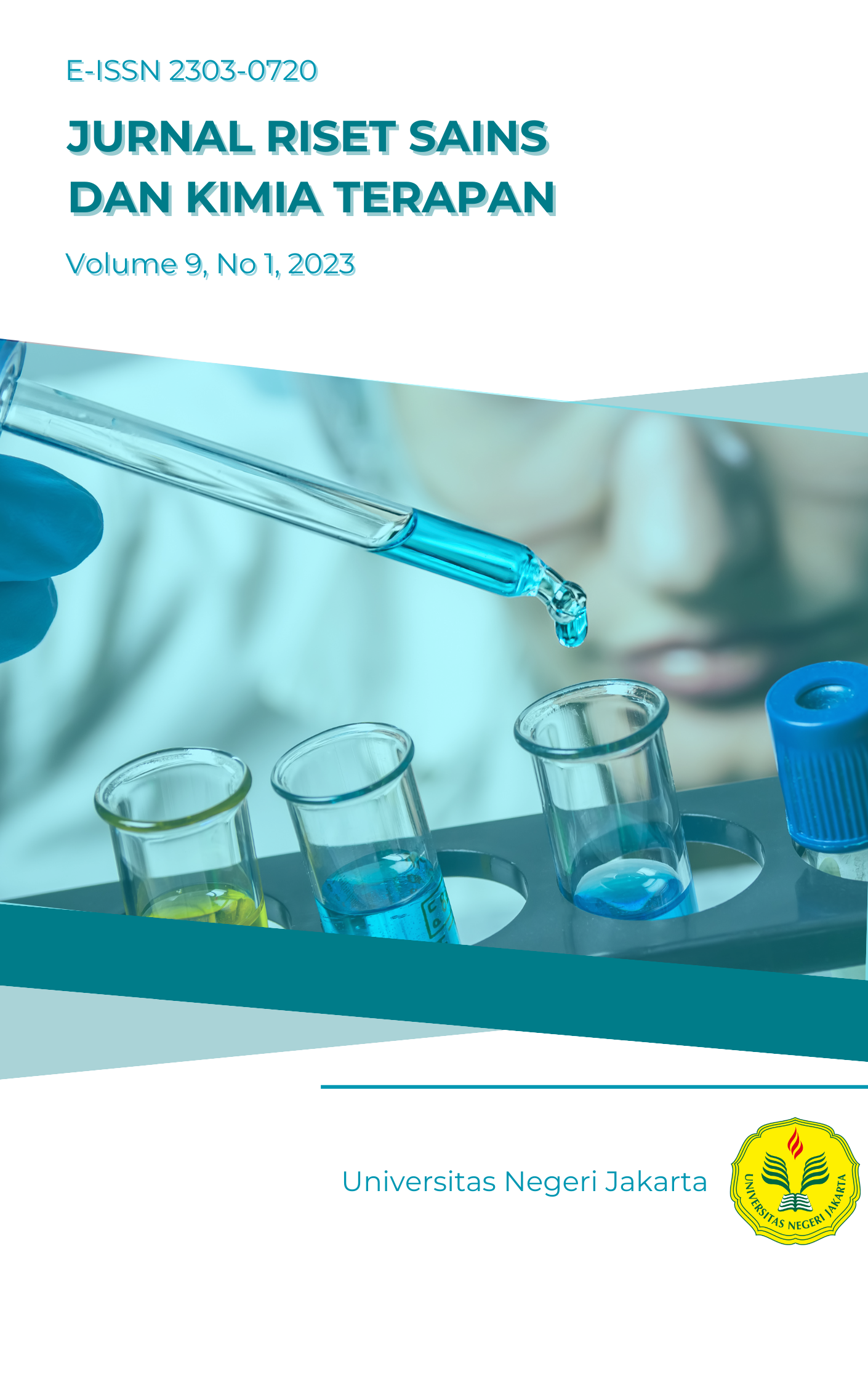Analisis Kandungan Logam Dan Ftalat pada Komponen Eletronik menggunakan XRF dan Py/GC-MS
DOI:
https://doi.org/10.21009/JRSKT.101.02Keywords:
elektronik, ftalat, logam, Py-GC-MS, RoHS, XRFAbstract
Abstrak
Perkembangan elektronik pada bidang industri mempengaruhi kehidupan sehari hari. Penggunaannnya yang berlebihan dapat meningkatkan resiko berbahaya pada penggunanya. Salah satu faktor bahaya pada komponen elektronik yang digunakan adalah terdapatnya logam dan flatat. RoHS merupakan regulasi Uni Eropa yang mengatur pembatasan penggunaan zat-zat berbahaya seperti Pb, Hg, Cd, dan Cr6+, serta PBB, PBDE, DIBP, DBP, BBP, dan DEHP dalam produk-produk elektronik dan listrik. Penelitian ini bertujuan untuk mengetahui kandungan zat-zat berbahaya yang diatur oleh RoHS pada sampel komponen elektronik. Metode yang digunakan adalah skrining awal menggunakan XRF dan penetapan kadar ftalat dengan Py/GC-MS. Hasil penelitian menunjukkan bahwa sampel tidak mengandung logam berat (Cd, Hg, Cr), DIBP, BBP, dan turunan Br. Kandungan Pb, DBP, dan DEHP yang terdeteksi memiliki konsentrasi rendah dan tidak melebihi batas maksimum penggunaan ftalat yang ditetapkan oleh RoHS, sehingga part elektronik tersebut dapat digunakan dalam produksi.
Kata kunci: elektronik, ftalat, logam, Py-GC-MS, RoHS, XRF
Abstract
The development of electronics in the industrial sector affects daily life. Its excessive use can increase the risk of harm to its users. One of the hazardous factors in the electronic components used is the presence of metals and flattates. RoHS is a European Union regulation that regulates restrictions on the use of hazardous substances such as Pb, Hg, Cd, and Cr6+, as well as PBB, PBDE, DIBP, DBP, BBP, and DEHP in electronic and electrical products. This study aims to determine the content of RoHS-regulated hazardous substances in electronic component samples. The methods used were preliminary screening using XRF and determination of phthalate levels by Py/GC-MS. The results showed that the samples did not contain heavy metals (Cd, Hg, Cr), DIBP, BBP, and Br derivatives. The detected Pb, DBP, and DEHP contents had low concentrations and did not exceed the maximum limit of phthalate use set by RoHS, so the electronic parts could be used in production.
Keywords:electronics, metals, phthalates, Py-GC-MS, RoHS, XRF
References
Ahn, C., & Jeung, E.-B. (2023). Endocrine-Disrupting Chemicals and Disease Endpoints. International Journal of Molecular Sciences, 24(6), 5342. https://doi.org/10.3390/ijms24065342
Arigò, A., Famiglini, G., Marittimo, N., Agostini, M., Renzoni, C., Palma, P., & Cappiello, A. (2023). Extractive-liquid sampling electron ionization-mass spectrometry (E-LEI-MS): a new powerful combination for direct analysis. Scientific Reports, 13(1), 6429. https://doi.org/10.1038/s41598-023-33647-5
Arrigo, F., Impellitteri, F., Piccione, G., & Faggio, C. (2023). Phthalates and their effects on human health: Focus on erythrocytes and the reproductive system. Phthalates and Their Effects on Human Health: Focus on Erythrocytes and the Reproductive System, 270, 109645–109645. https://doi.org/10.1016/j.cbpc.2023.109645
Bansal, P. (2023). Metal extraction by selective sulfidation of compounds is beneficial for recycling. MRS Bulletin, 48(5), 440–440. https://doi.org/10.1557/s43577-023-00528-1
da Costa, J. M., Kato, L. S., Galvan, D., Lelis, C. A., Saraiva, T., & Conte-Junior, C. A. (2023). Occurrence of phthalates in different food matrices: A systematic review of the main sources of contamination and potential risks. Comprehensive Reviews in Food Science and Food Safety, 22(3), 2043–2080. https://doi.org/10.1111/1541-4337.13140
Deejay, A., & Henne, K. (2023). Creating a New Normal? Technosocial Relations, Mundane Governance and Pandemic-Related Disruption in Everyday Life. Sociology, 58(3), 699–716. https://doi.org/10.1177/00380385231205135
Franjić, S., & Marappan, R. (2022). Role of Electronic Components in Computing. International Journal of Mathematical, Engineering, Biological and Applied Computing, 1(1), 47–48. https://doi.org/10.31586/ijmebac.2022.336
Frydrych, A., & Jurowski, K. (2023). Portable X-ray fluorescence (pXRF) as a powerful and trending analytical tool for in situ food samples analysis: A comprehensive review of application - State of the art. TrAC Trends in Analytical Chemistry, 166, 117165. https://doi.org/10.1016/j.trac.2023.117165
Gaur, K., & Siddique, Y. H. (2023). Phthalate-induced Toxicity and its Mitigation by Natural Plant Products. Current Traditional Medicine, 10. https://doi.org/10.2174/0122150838268882231006094411
Kumar, A., Kumar, V., Pandita, S., Singh, S., Bhardwaj, R., Varol, M., & Rodrigo-Comino, J. (2023). A global meta-analysis of toxic metals in continental surface water bodies. Journal of Environmental Chemical Engineering, 11(3), 109964–109964. https://doi.org/10.1016/j.jece.2023.109964
Lozano, M., Broberg, K., Soler-Blasco, R., Murcia, M., Riutort-Mayol, G., Ballester, F., Esplugues, A., Manyes, L., Escrivá, L., Correcher, J. F., Peiró, J., Casas, M., Guxens, M., Irizar, A., Lertxundi, N., & Llop, S. (2022). Prenatal metals exposure and pre-adolescents’ emotional and behavioral problems. Environmental Health Perspectives. Supplements, 2022(1). https://doi.org/10.1289/isee.2022.p-1010
Murali, A., Sarswat, P. K., Benedict, J., Plummer, M. J., Shine, A. E., & Free, M. L. (2021). Determination of metallic and polymeric contents in electronic waste materials and evaluation of their hydrometallurgical recovery potential. International Journal of Environmental Science and Technology, 19(4), 2295–2308. https://doi.org/10.1007/s13762-021-03285-3
Muscat, M., Sinagra, E., & Lia, F. (2023). Presence of Phthalate Esters Used as Common Plasticisers in Maltese Shoreline Sand. Environments, 10(6), 94–94. https://doi.org/10.3390/environments10060094
Natsch, A., Adamsson, G., & Rocha, V. (2023). ECHA ARN documents: chemical grouping without a toxicological rationale. Archives of Toxicology, 97(5), 1433–1437. https://doi.org/10.1007/s00204-023-03479-3
Naz, Z., Shrestha, R., Moin, S. T., & Monticelli, L. (2022). Interaction of Phthalates with Lipid Bilayer Membranes. The Journal of Physical Chemistry, 126(25), 4679–4688. https://doi.org/10.1021/acs.jpcb.2c02007
Ohgaki, M., Takeguchi, Y., Okawa, S., & Namiki, K. (2019). Screening analysis of RoHS directive hazardous substances (phthalate esters and bromodiphenyl ethers) by novel mass spectrometry using soft ionization. Royal Society Open Science, 6(2), 181469. https://doi.org/10.1098/rsos.181469
Sahoo, P. K., & Nanda, M. K. (2023). A modified partitioning algorithm for classification of e-waste. Journal of Statistics and Management Systems, 26(1), 53–65. https://doi.org/10.47974/jsms-947
Tolkou, A. K., Toubanaki, D. K., & Kyzas, G. Z. (2023). Detection of Arsenic, Chromium, Cadmium, Lead, and Mercury in Fish: Effects on the Sustainable and Healthy Development of Aquatic Life and Human Consumers. Sustainability, 15(23), 16242. https://doi.org/10.3390/su152316242
Wądrzyk, M., Plata, M., Zaborowska, K., Janus, R., & Lewandowski, M. (2021). Py-GC-MS Study on Catalytic Pyrolysis of Biocrude Obtained via HTL of Fruit Pomace. Energies, 14(21), 7288. https://doi.org/10.3390/en14217288
Yuan, Z., Huang, Q., Wang, Z., Wang, H., Luo, J., Zhu, N., Cao, X., & Lou, Z. (2022). Medium-Low Temperature Conditions Induce the Formation of Environmentally Persistent Free Radicals in Microplastics with Conjugated Aromatic-Ring Structures during Sewage Sludge Pyrolysis. Environmental Science & Technology, 56(22), 16209–16220. https://doi.org/10.1021/acs.est.2c04453
Zhang, S., Guo, A., Fan, T.-T., Rong, Z., & Niu, Y. (2019). Phthalates in residential and agricultural soils from an electronic waste-polluted region in South China: distribution, compositional profile and sources. Environmental Science and Pollution Research, 26(12), 12227–12236. https://doi.org/10.1007/s11356-019-04669-2







